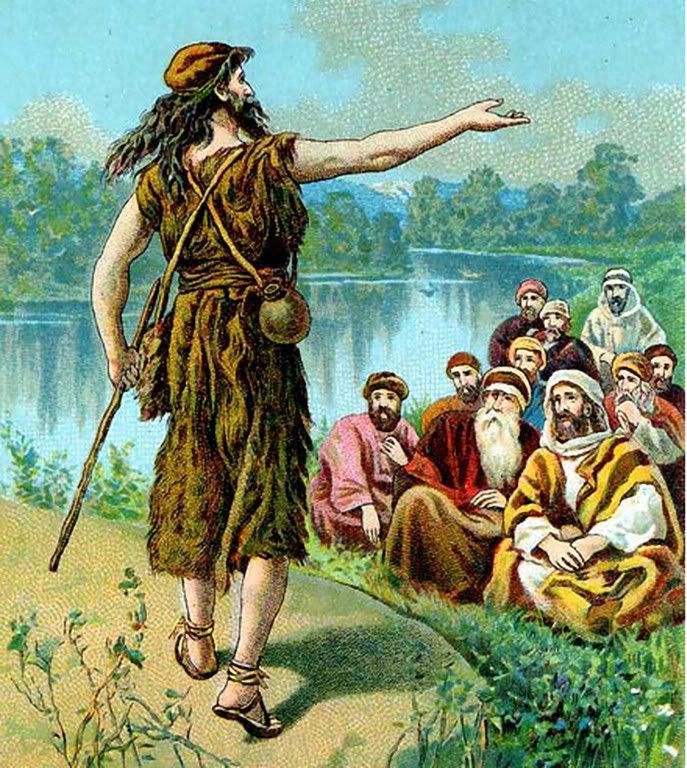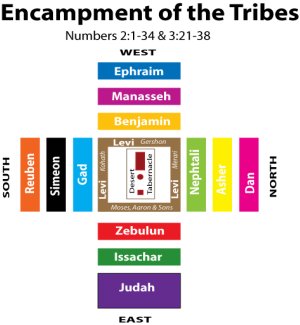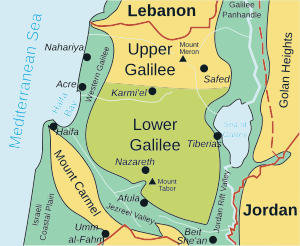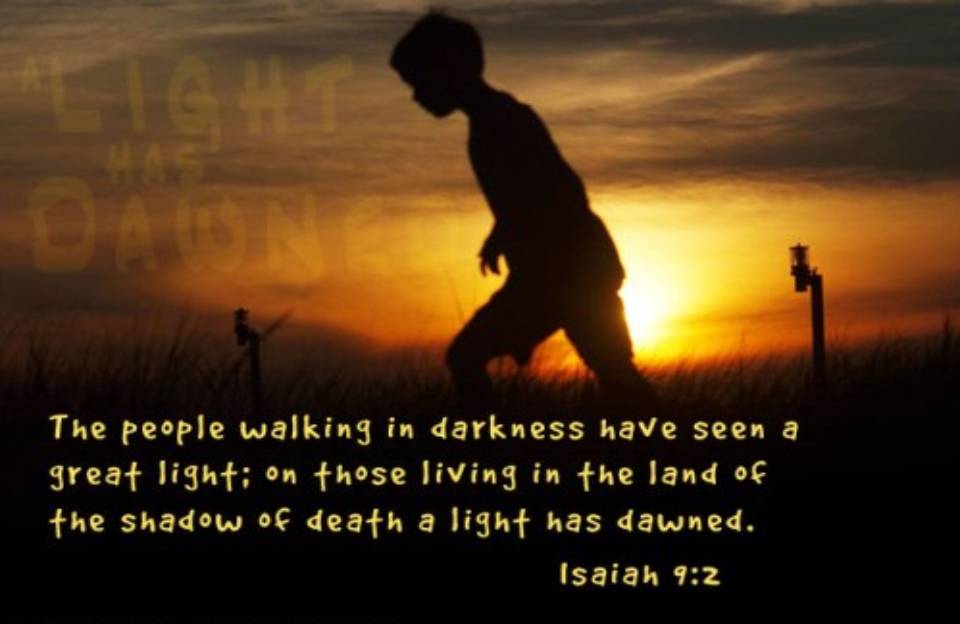Mat 4:12 Now when Jesus heard that John was thrown into prison, He withdrew into Galilee,
Mat 4:13 and leaving Nazareth He went and settled at Capernaum, a town by the Lake on the frontiers of Zebulun and Naphtali,
Mat 4:14 in order that these words, spoken through the Prophet Isaiah, might be fulfilled,
Mat 4:15 "ZEBULUN'S LAND AND NAPHTALI'S LAND; THE ROAD BY THE LAKE; THE COUNTRY BEYOND THE JORDAN; GALILEE OF THE NATIONS!
Mat 4:16 THE PEOPLE WHO WERE DWELLING IN DARKNESS HAVE SEEN A BRILLIANT LIGHT; AND ON THOSE WHO WERE DWELLING IN THE REGION OF THE SHADOW OF DEATH, ON THEM LIGHT HAS DAWNED."
Mat 4:17 From that time Jesus began to preach. "Repent," He said, "for the Kingdom of the Heavens is now close at hand."
 |
| John the Baptist preaching at the Jordan River |
Before someone begins to preach the Word of God they need to experience Temptation and Testing to see if their faith and call are genuine. Jesus was lead into temptation by the Holy Spirit. God will arrange the circumstances of our lives so that we can really know that we are ready. A sprinter does not test his speed only on the day of the race. No. he continually increases the pressure and the exercises and sprints so that he is ready and his muscles are taught, trim and terrific for the big race.
After the temptations in the Desert Now Jesus is ready to start His Public Ministry.
Mat 4:12 Now when Jesus heard that John was thrown into prison, He withdrew into Galilee,
Mat 4:13 and leaving Nazareth He went and settled at Capernaum, a town by the Lake on the frontiers of Zebulun and Naphtali,
How interesting that the Last Great Prophet of the OT era would be thrown into Prison before jesus began His ministry.
Jesus was beginning a new Dispensation, and New Kingdom based on different rules and principles. No longer obedience to the Law but Faith in the Messiah of God.
Mat 4:13 and leaving Nazareth He went and settled at Capernaum, a town by the Lake on the frontiers of Zebulun and Naphtali,
Capernaum:the field of repentance; city of comfort - Hitchcock
Eaton’s Bible Dictionary Nahum's town, a Galilean city frequently mentioned in the history of our Lord. It is not mentioned in the Old Testament. After our Lord's expulsion from Nazareth (Mat_4:13-16; Luke 4:16-31), Capernaum became his “own city.” It was the scene of many acts and incidents of his life (Mat_8:5, Mat_8:14, Mat_8:15; Mat_9:2-6, Mat_9:10-17; 15:1-20; Mar_1:32-34, etc.). The impenitence and unbelief of its inhabitants after the many evidences our Lord gave among them of the truth of his mission, brought down upon them a heavy denunciation of judgement (Mat_11:23).
Mat 11:23 And [woe to ] you, Capernaum, who are exalted to the heaven, shall be brought down to hell. For if the mighty works which have been done in you had been done in Sodom, it would have remained until this day.
Mat 11:24 But I say to you, it shall be more tolerable for the land of Sodom in the day of judgment than for you.
From his hometown to his new centre of ministry. From Nazareth He went to Capernaum by the Sea of Galilee.
 |
| Archealogical diggings at Capernaum |
along the frontiers of Zebulun and Naphtali,
Zebulun
The Blessings for them
Jacob's Blessing - Genesis 49:13
"Zebulun shall dwell toward the seashore; And he shall be a haven for ships, And his flank shall be toward Sidon."
Moses Blessing - Deuteronomy 33:18
"Rejoice, Zebulun, in your going forth."
Naphtali
Jacob's Blessing - Genesis 49:21
"Naphtali is a hind let loose, he gives beautiful words."
Moses Blessing - Deut. 33:23
"...'O Naphtali, satisfied with favor, and full of the blessing of the Lord, take possession of the sea and the south.' "
THE LAND ALLOTMENT
Of the 12 tribes of Israel, none received land more beautiful than this tribe. Their land has been called the "Garden of Palestine".
Their inheritance fell in the region of Galilee. Centered around the shores of the Sea of Galilee, this tribe possessed the most fertile and productive region in all of Canaan.
3
Shepherds and farmers alike found the soil and vegetation of this area extremely fertile, and able to support large flocks and herds. The whole of the land is fed by hidden springs emanating from Mount Herman. This area is well watered by multiple sources; principally the Jordan River, the springs of Mt. Herman, and the Sea of Galilee.
Mount Herman is just 39 miles northeast of where the Jordan River runs into the Sea of Galilee. In antiquity, the mountains of Galilee bore the name the Mountains of Naphtali.
Their allotment was inherited after the conflict with the Canaanite forces at the Waters of Merom in Joshua 11. Along with this tribe, the tribes of Benjamin, Dan, Issachar, Simeon and Zebulun also received their allotments after this battle.
The Biblical description of the allotted land can be found in Joshua 19:32-39.
"The sixth lot fell to the sons of Naphtali; to the sons of Naphtali according to their families. And their border was from Heleph, from the oak in Zaanannim and Adami-nekeb and Jabneel, as far as Lakkum; and it ended at the Jordan. Then the border turned westward to Anath-tabor, and proceeded from there to Hukkok; and it reached to Zebulun on the south and touched Asher on the west, and to Judah at the Jordan toward the east."
The first three verses identify the tribal borders, starting in the southern portion of the tribal allotment. As can be seen on the map, Heleph has not been positively identified. The tribe's border ran from Heleph, thought to have existed to the north of Mt. Tabor, east towards the "oak in Zaanannim".
This same phrase was used to describe the area Sisera, king Jabin of Hazor's military commander, fled to in the engagement with Deborah and Barak found in Judges 4. This landmark was apparently well known in ancient times, and bears similarity to the dwelling of Abraham in Genesis 13:18 at the "oaks of Mamre".
Zaanannim's location is not certain. However, based on the geography of the Biblical description of the war with Jabin and Sisera, it would seem this city was to the immediate south - southeast of the Sea of Galilee. This would place the city likely in-between Beth-shemesh and Jabneel. However, it has also been identified as lying north of Mt. Tabor, as indicated on the city map.
Wherever the city was located, Naphtali's border stopped at the Jordan River. The description starts with Heleph, and moves eastward, encountering the cities mentioned along the way, until the border reached the Jordan River. From Heleph, the border extended westward to Anath-tabor, a city just north of Mt. Tabor. From here, the border incorporated the village of Hukkok.
Mat 4:14 in order that these words, spoken through the Prophet Isaiah, might be fulfilled,
Mat 4:15 "ZEBULUN'S LAND AND NAPHTALI'S LAND; THE ROAD BY THE LAKE; THE COUNTRY BEYOND THE JORDAN; GALILEE OF THE NATIONS!
Mat 4:16 THE PEOPLE WHO WERE DWELLING IN DARKNESS HAVE SEEN A BRILLIANT LIGHT; AND ON THOSE WHO WERE DWELLING IN THE REGION OF THE SHADOW OF DEATH, ON THEM LIGHT HAS DAWNED."
Mat 4:16 the people dwelling in darkness have seen a great light, and for those dwelling in the region and shadow of death, on them a light has dawned."
GALILEE OF THE NATIONS!
Galilee of the Gentiles - Galilee was divided into upper and lower Galilee. Upper Galilee was called Galilee of the Gentiles, because it was occupied chiefly by Gentiles. It was in the neighborhood of Tyre, Sidon, etc. The word “Gentiles” includes in the Scriptures all who are not Jews. It means the same as nations, or, as we should say, the pagan nations. Barnes
The Upper Galilee (Hebrew: הגליל העליון, HaGalil Ha'Elion) is a geographical-political term in use since the end of the Second Temple period, originally referring to a mountainous area overlapping the present northern Israel and southern Lebanon, its borders being the Litani river in the north, the Mediterranean Sea in the west, the Beit HaKerem valley and Lower Galilee in the south and the Jordan river and Hula Valley in the east.[1] Wikipedia
Mat 4:16 THE PEOPLE WHO WERE DWELLING IN DARKNESS HAVE SEEN A BRILLIANT LIGHT; AND ON THOSE WHO WERE DWELLING IN THE REGION OF THE SHADOW OF DEATH, ON THEM LIGHT HAS DAWNED."
dwellingt in darkness.
I. The deep darkness which envelops the world without the gospel. “Darkness “ and “the region of the shadow of death,” striking emblems of error, ignorance, sin, guilt, misery, danger.
1. The heathen world is in this darkness (Rom_1:18-32).
2. In the very midst of Christendom there is this darkness. Home heathenism, etc. The condition of all unregenerate men.B.I.
The people which sat in darkness - This is quoted from Isa_9:2, where, instead of sitting, the prophet used the word walked. The evangelist might on purpose change the term, to point out the increased misery of the state of these persons. Sitting in darkness expresses a greater degree of intellectual blindness, than walking in darkness does. In the time of Christ’s appearing, the people were in a much worse state than in the time of the prophet, which was nearly 700 years before; as, during all this period, they were growing more ignorant and sinful.
The region and shadow of death - These words are amazingly descriptive. A region of death - Death’s country, where, in a peculiar manner, Death lived, reigned, and triumphed, subjecting all the people to his sway.
Shadow of death - Σκια θανατου, used only here and in Luk_1:79, but often in the Old Covenant, where the Hebrew is צל מות tsal maveth, It is not easy to enter fully into the ideal meaning of this term. As in the former clause, death is personified, so here. A shadow is that darkness cast upon a place by a body raised between it and the light or sun. Death is here represented as standing between the land above mentioned, and the light of life, or Sun of righteousness; in consequence of which, all the inhabitants were, involved in a continual cloud of intellectual darkness, misery, and sin. A.Clark
I. Some souls are in greater darkness than others.
1. The darkness of ignorance.
2. The darkness of error.
3. The gloom of discomfort and sorrow, attended with fear.
4. Hopelessness, “sat in darkness.”
5. In the region of death.
Have seen a Great Light..............the Light has dawned







No comments:
Post a Comment